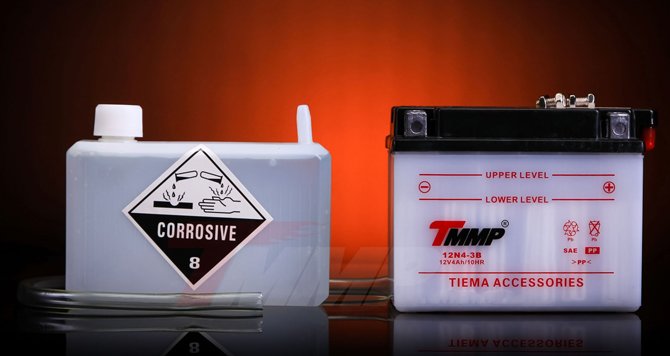There is nothing eternal, especially for a car and its components. There comes a time when the battery is running out of battery life. When this happens, the car owner goes to the store to buy a new power source.
Battery life, as a rule, does not exceed 3-5 years. Probably not as much as I would like. But nowhere to go, because without it the car would not start. It performs other functions, but it is the start of the engine that is the main task of the battery.
Content
What is a dry-charged battery?
Each driver has a choice: buy a dry-charged or electrolyte-charged battery. Any seller will say that the main advantage of a dry-charged battery is the possibility of long-term storage, and a charged one - immediate operation. But is it so difficult to commission dry-charged car power supplies, and is the game worth the candle?
The dry-charged battery has plates that are formed and charged at the factory, and which must be independently charged with electrolyte. After assembly at the factory, the battery is hermetically sealed with plugs to prevent moisture or air from entering it.
The main advantage of a dry-charged battery is its long shelf life. When he arrives at the buyer, he can be sure that he is in good condition and will last longer than a seasoned and defended several years in anticipation of the first operation of the new owner.
Where are dry-charged batteries used?
Dry-charged batteries in their functionality are no different from ordinary batteries. They can be installed on the following types of vehicles:
- A car;
- Freight car;
- Bus;
- Minibus;
Advantages and disadvantages of a dry-charged battery
Today, most drivers choose batteries that already have electrolyte. There are reasons for that.
Disadvantages of dry-charged batteries:
- They can not be installed on the car immediately after purchase.
- You will have to spend some time preparing them.
- You must buy electrolyte or do it yourself.
- You need to have some preparation to prepare the solution and charge the battery.
- A charging station is required.
- This is a serviceable battery type.
Preparation of a dry-charged battery begins with the creation of a mixture of sulfuric acid and distilled water. It is necessary that the solution has the required density. It may take 5 to 7 hours to charge the prepared battery.
Attention! An electrolyte is a toxic liquid that, if it comes into contact with the skin and mucous membranes, can cause severe harm to humans.
The advantages of dry-charged batteries:
- Unlike ordinary batteries, it does not have chemical reactions before operation.
- Longer shelf life.
- You can adjust the density.
- Safety and ease of transportation.
Despite the equal number of advantages and disadvantages of a battery without an electrolyte, it is still profitable to purchase. After all, the shortcomings that we have listed are relative. Yes, installing a battery on a car is not immediately possible, but only if there is no ready-made mixture at hand, which can also be purchased at a store.
The density of the mixture of such a solution has an optimal value. The containers in which the electrolyte is sold has a special neck that allows the mixture to be poured without problems.If you do everything carefully and observe safety precautions, nothing terrible can happen.
Commissioning a dry-charged battery
The following operations are performed to refuel a dry-charged battery:
- Opening venting hole.
- Removing the protective tape from the openings of the cans.
- Unpacking the container with electrolyte. It can represent soft packaging, a tight cardboard box wrapped with tape, a plastic bag with a zip-lock.
- Removing the plastic strip-plug of the battery and removing the protective foil from the outlet holes.
- Take the battery in your hand, turn it over, and with the second hand take the container in which the electrolyte is poured.
- Next, bring the container with the liquid and insert it into the holes by turning over these two elements. The jars will be ready when the electrolyte in them reaches a special mark on the case or does not bury the plates 3-5 mm higher. The optimum density of the electrolyte is -1.28 kg / l.
- After removing the plastic container, wait 1 hour for the plates to become saturated with electrolyte.
- Swing the battery to fill in the voids and top up the electrolyte. If the temperature rises above 20 degrees Celsius, you must wait for the battery to cool.
- After that, the density of the electrolyte is measured. If the value is 1.25 g / cm3, then it can be operated. Otherwise, the battery must be charged at the station.
How to charge a dry-charged battery
In order for the battery to be considered charged, it is necessary that the voltmeter output 12.5 or more volts. The state in which it can be recharged is 10.5 V. Otherwise, it will be difficult to restore it, if not unrealistic. With a new dry-charged battery, this will not be a problem. The main thing is to pour electrolyte with a fixed density into it.
Battery Charging Instructions:
- It is necessary to connect the terminals “+” and “-” to the charger, observing the polarity.
- Turn on the charging station.
- The charge current must be set to 10% of the battery capacity.
- Charge for 5 hours.
- If the battery does not provide the necessary voltage, it is necessary to reduce the charge by 50% and wait another 4 hours.
A fully charged battery will boil, which can be observed with the naked eye. The value of electrolyte density and voltage at the terminals will be constant.
Still have questions aboutDry charged batteries or have something to add? Then write to us about it in the comments, this will make the material more useful, complete and accurate.









